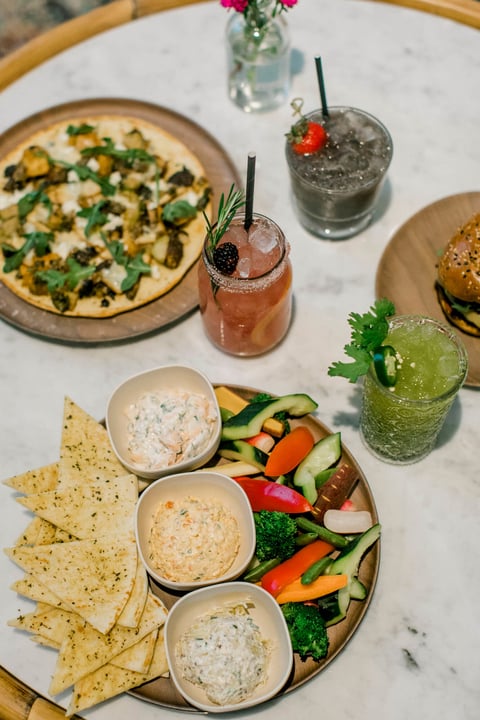Sharing food has become a “thing.”
At the newest Flower Child from Fox Restaurant Concepts, located in Dallas, shared dishes are a focal point of one part of the experience.
“Generation Z and younger Millennials seek out shareable foods, in part to be social and convivial, and in part because many are used to making whole meals out of snacks and small bites,” says Kara Nielsen, food trend expert in Oakland, Calif. “Variety, multiple textures and bold flavors are also part of the experience. With that in mind, shareable items need to work harder to be craveable, offer positive nutrition and work for vegans or gluten-free diners who may be part of a group.”
Flower Child, which is a fast casual concept with 24 locations, opened the Dallas unit with two sides—a fast casual restaurant and a lounge serving shareable plates and cocktails.

What was important for the shared plates—as well as the cocktails—was “to stay on brand,” says Matthew Schaefer, the concept’s regional chef. “Flower Child is known for healthy options and we didn’t want to blow that up with chicken wings and nachos and things like that.” On the menu are dips like smoked gouda pimiento, salmon and dill, and artichoke-black truffle; a vegan chef board (walnut pesto eggplant, aleppo Brussels sprouts, smoked almonds and “ricotta,” portobello lardons, organic apple, fig and quince marmalade, toasted baguette, sweet potato chicharrón), $13 turmeric-glazed shrimp and chicken skewers ($11); and a grass-fed burger ($12).
“We knew we wanted things you could eat with your fingers,” Schaefer says. “It’s good for pre-party so people can eat before they go out drinking. They can have a light bite, feel filled up but not feel gross.”
Give this a read: Survey Reveals What College Students Want to Drink
The dips are the most popular and cost $7 or $8 each, or $20 for a trio (choose your own). These come with pita and crudites.
The cocktails at this Flower Child are healthy, too. “They have alcohol but are made with botanicals and are herbaceous, with lots of house-infused products, hibiscus and kombucha. Together with the shareables, “they’re pretty symbiotic,” says Schaefer. He and the mixologist created their products and tasted each other’s, then as they got closer to opening, would taste them together, to pair them well.
There are challenges when creating a shareables menu, Shaefer says. “You have to think about how people will get the food to their mouth and they have to be able to pick things up. Our burger is kind of clean and doesn’t have a lot of stuff oozing out of it; we cut the pitas for the dips to the right size. You don’t want things that are going to burst all over the place.”
The food costs on these dishes are slightly higher than most of Flower Child’s other food, Shaefer says, but the cocktails are bringing in extra revenue “so it all comes out in the wash because we’re bringing in people we wouldn’t otherwise.”
Give this a read: ANA, LA Fund & Intel Solving the Hospitality Industry's Innovation Crisis
Labor-wise, the shareables don’t require too much, and there are no additional staff or stations in the kitchen of the fast-casual to contend with this, though more kitchen hands may be on later in the day for the happy hour crowd and beyond.
Most of the dishes on the shareables menu are unique to the lounge and not duplicated in the fast casual side of Flower Child. However, “if we were to streamline that menu, we’d be able to duplicate the prep,” Schaefer says. He points in particular to one labor-intensive dish—a dehydrated tapioca sweet potato puff (sweet potato chicharrón)—“but the cooks love it because it’s a super cheffy item and the only one we have.”
Resources
